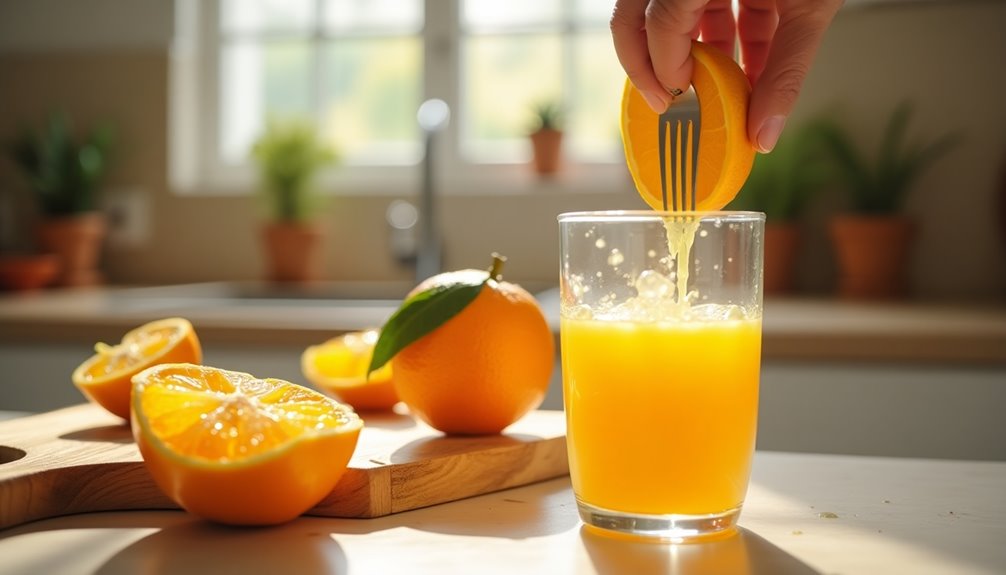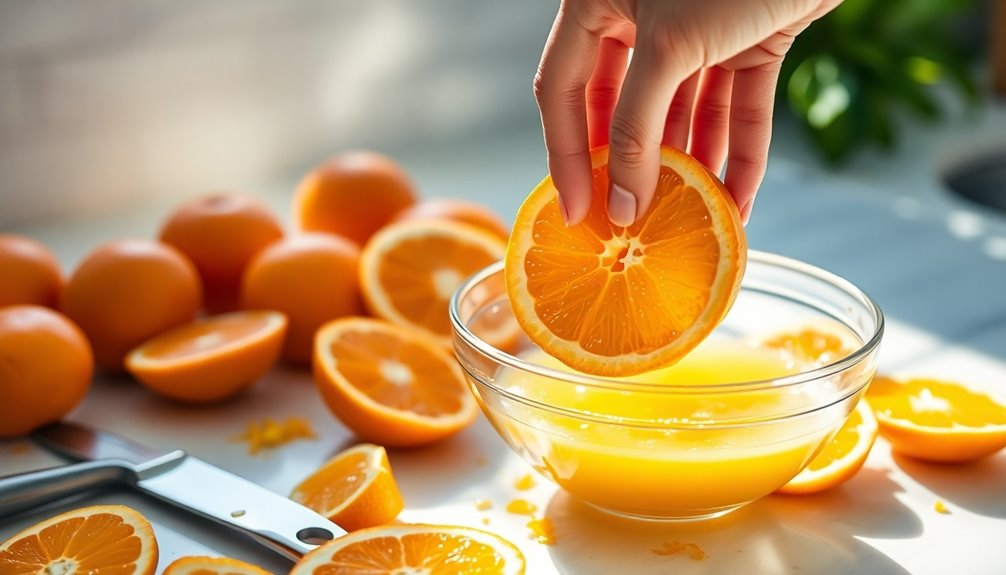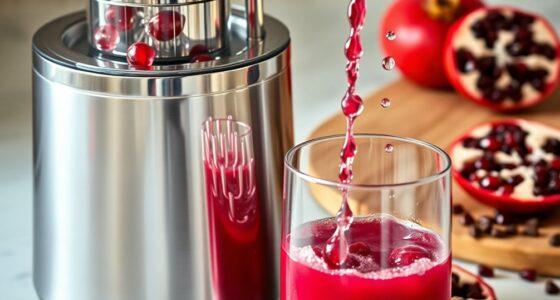Juicing oranges without a juicer is easy! Start by cutting the oranges in half and squeezing them over a bowl for maximum juice extraction. To get more juice, twist the halves or use a fork to press the pulp. Alternatively, peel and chop the oranges, then blend them with a bit of water until smooth. Strain through a fine mesh sieve to enjoy fresh juice. Want to explore more tips and tricks? Keep going!
Key Takeaways
- Wash the oranges thoroughly to remove contaminants before juicing.
- Cut the oranges in half and hand-squeeze them over a bowl for juice extraction.
- Alternatively, peel and chop oranges, then blend with a little water for a smooth mixture.
- Strain the blended mixture through a fine mesh sieve or cheesecloth to separate juice from pulp.
- Store any leftover juice in an airtight container in the refrigerator for 2-3 days for freshness.

Juicing oranges without a juicer is surprisingly easy and can be done in just a few simple steps. First, you'll want to start with some fresh oranges. Make sure to wash the oranges thoroughly under running water to remove any dirt or contaminants on the skin. This step ensures that your homemade orange juice isn't only delicious but also safe to drink.
Once they're clean, you can move on to the fun part—juicing! Grab a cutting board and a sharp knife, then cut the oranges in half. You're going to want to squeeze the juice out of each half directly over a bowl. This helps collect all the juice without making a mess. Use your hands to press and twist the orange halves, ensuring you're extracting as much juice as possible.
If you find that some pulp remains after your initial squeezing, don't worry! For an even higher yield, take a fork and press it against the remaining pulp in the orange halves. This little trick can help you extract any additional juice that might be hiding.
If you prefer a different method, you can peel the oranges and chop them into smaller pieces. Place these pieces into a blender with a small amount of water. Blend until you achieve a smooth mixture, then strain the juice through a fine mesh sieve or cheesecloth to remove the pulp. This method will also give you a refreshing drink, but be sure to squeeze out every last drop for the best results.
Regardless of the method you choose, the goal is to enjoy that fresh, homemade orange juice. Remember that freshly squeezed juice is best consumed immediately for optimal freshness. However, if you need to store it, place the juice in an airtight container and keep it in the refrigerator. It should last for about 2-3 days, but you might want to drink it sooner to enjoy the vibrant flavor and nutrients.
When you've finished juicing, you can savor the health benefits of fresh oranges. They're packed with vitamin C and other essential nutrients, making your homemade orange juice not only tasty but also nutritious. You'll love the satisfaction of creating your own beverage and knowing exactly what went into it.
Frequently Asked Questions
How Do You Juice an Orange if You Don't Have a Juicer?
Juicing an orange without a juicer is simple!
Start by cutting the orange in half with a sharp knife, making sure to remove any stickers first.
Then, squeeze each half over a bowl or glass, applying firm pressure to get as much juice as possible.
For extra juice, use a fork to press against the pulp.
Finally, strain the juice through a sieve to remove any pulp or seeds, and enjoy!
What Can I Use as a Juicer if I Don't Have One?
If you don't have a juicer, don't worry! You can use a few simple tools instead. A handheld citrus squeezer or reamer works great for extracting juice from halved fruits.
You can also blend peeled, chopped fruit with a little water, then strain it for a smoother juice. Rolling the fruit on a hard surface before cutting helps loosen the rind, maximizing juice yield.
Just grab a fine mesh strainer to catch any pulp!
How to Juice an Orange With Your Hands?
Did you know that a medium orange contains about 70% water?
To juice an orange with your hands, start by rinsing it under running water. Cut it in half and squeeze each half over a bowl, applying firm pressure.
For more juice, use a fork to press against the pulp after squeezing. If you want it pulp-free, strain the juice through a sieve.
Enjoy the refreshing taste and health benefits!
How Do You Juice Citrus Without a Juicer?
You can easily juice citrus without a juicer by hand. Start by rolling the fruit on a hard surface to loosen the juice.
Then, cut the citrus in half and squeeze it over a bowl to catch the juice. For more extraction, use a fork to press against the pulp after squeezing.
If you prefer a smoother juice, strain it through a fine mesh strainer to remove any pulp or seeds. Enjoy!
Conclusion
Juicing oranges without a juicer is not only easy but also a fun way to enjoy fresh juice at home. Did you know that one medium orange contains about 70% of your daily vitamin C needs? By using simple methods like hand-squeezing or a fork, you can extract all that delicious juice and boost your immune system. So next time you crave a refreshing drink, grab some oranges and get to juicing without any fancy equipment!
Cindy thoroughly researches juicing trends, techniques, and recipes to provide readers with practical advice and inspiration. Her writing style is accessible, engaging, and designed to make complex concepts easy to understand. Cindy’s dedication to promoting the advantages of juicing shines through her work, empowering readers to make positive changes in their lives through the simple act of juicing.











